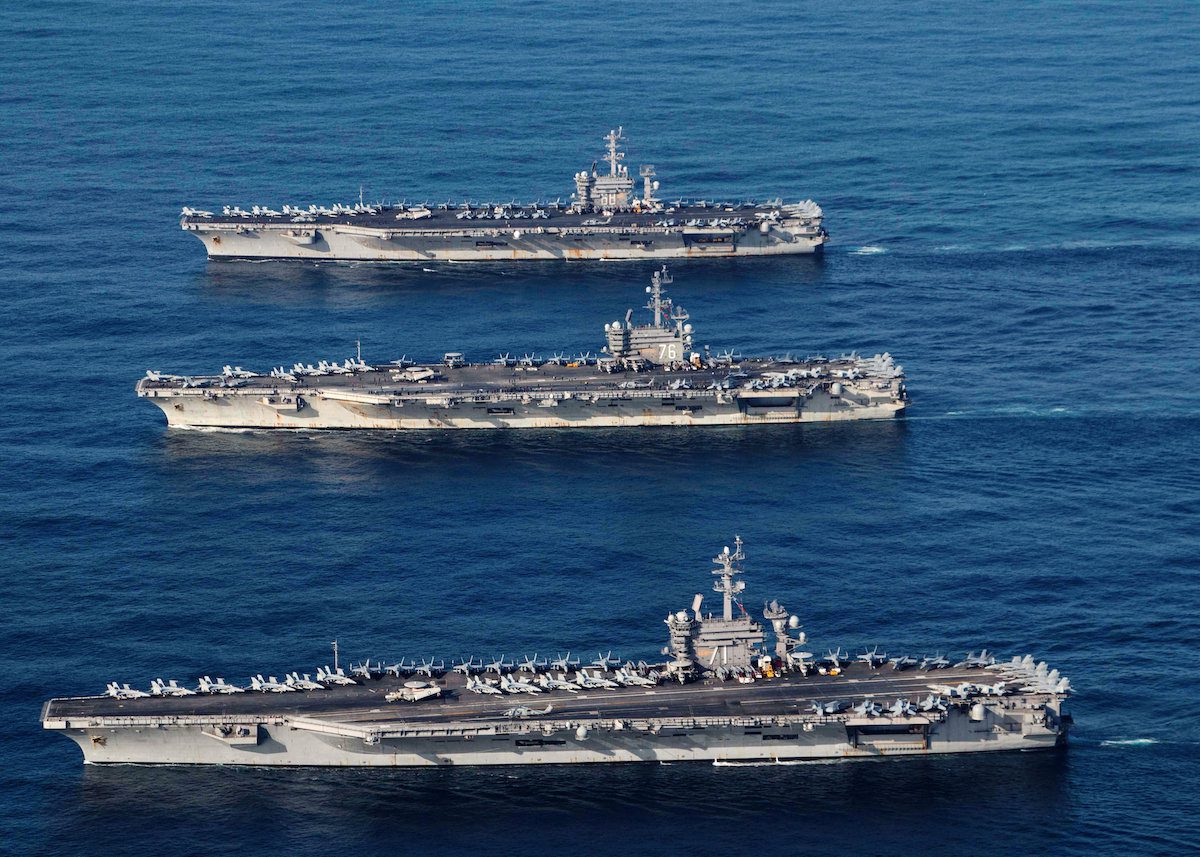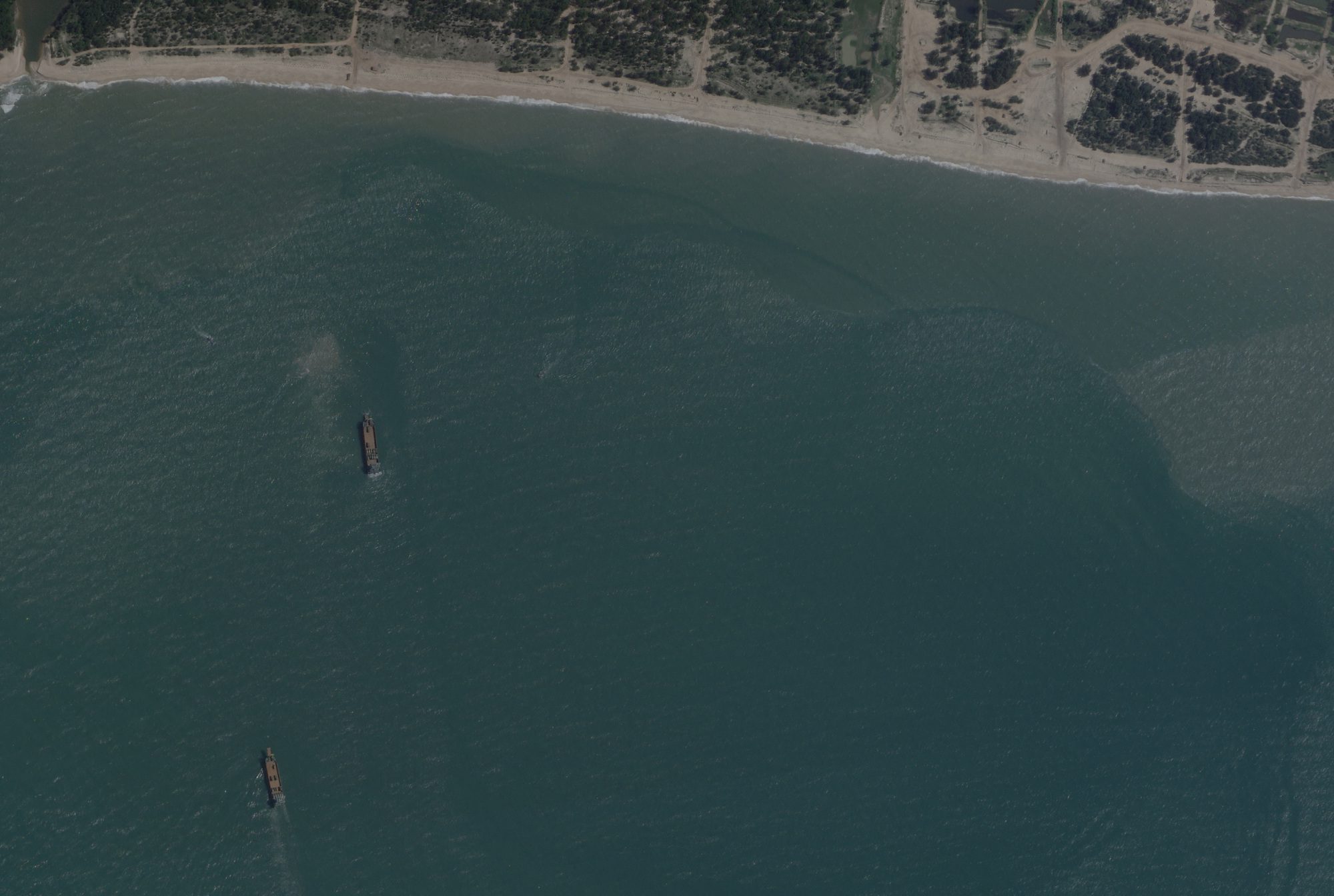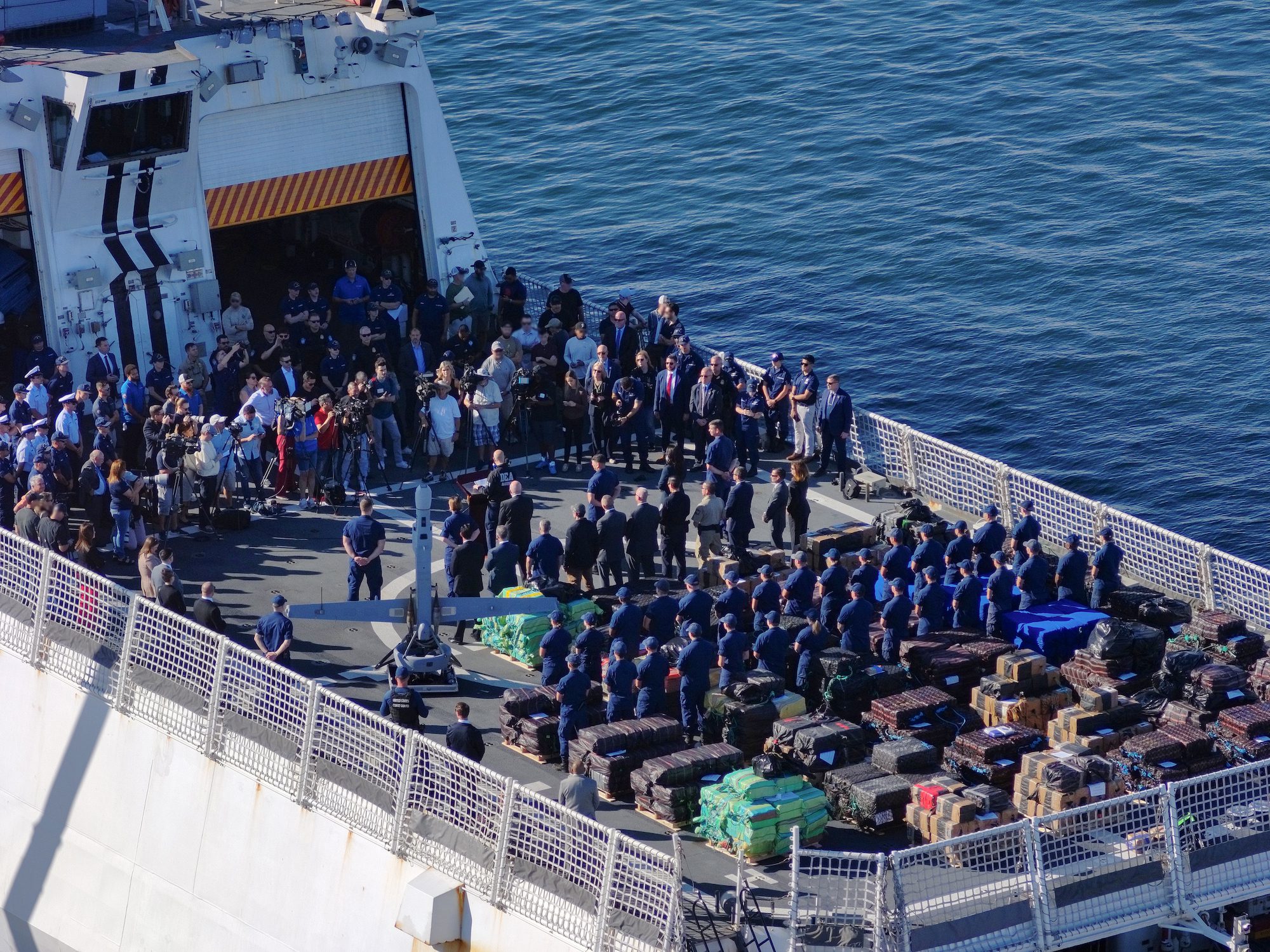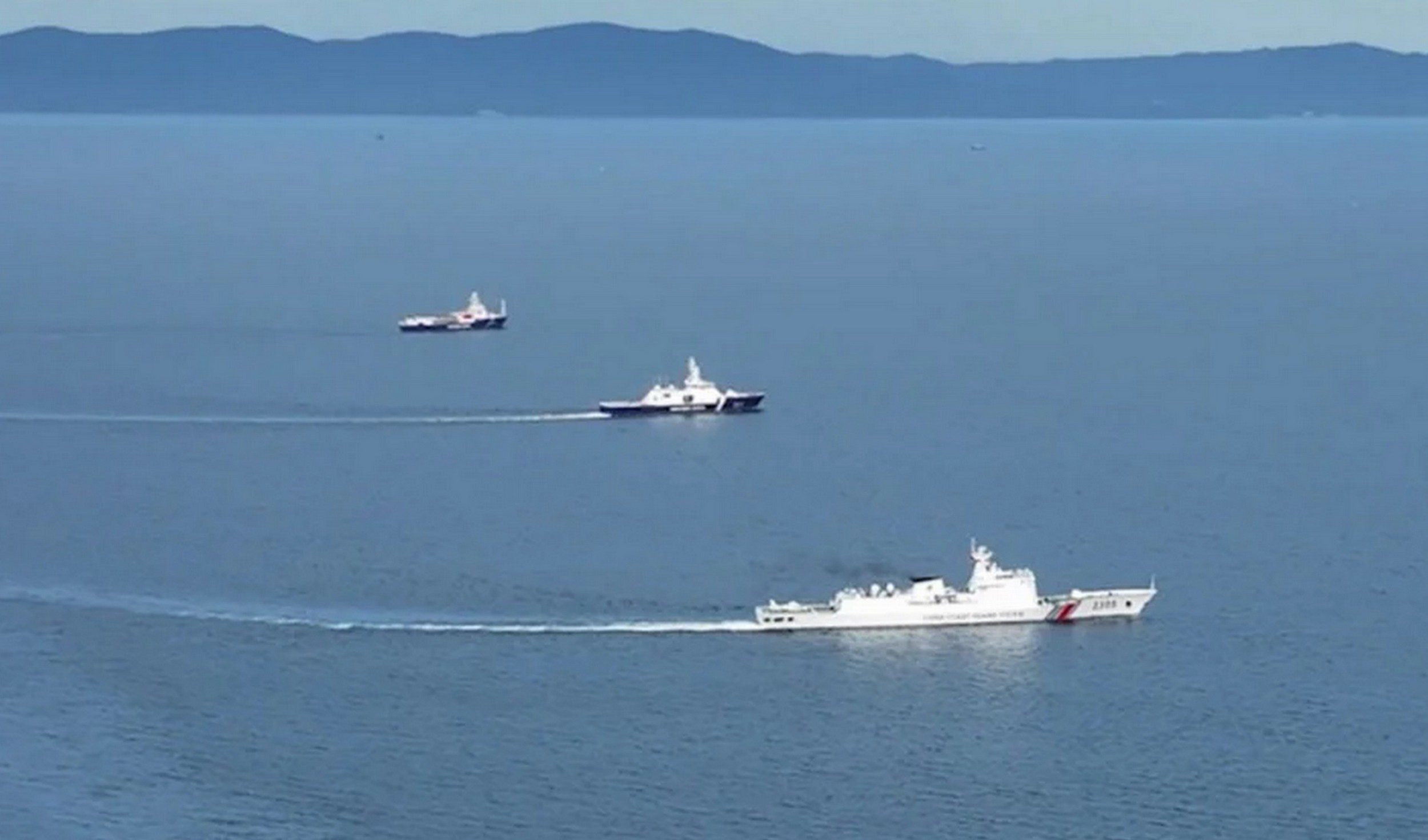FILE PHOTO – The aircraft carriers USS Ronald Reagan (CVN 76), USS Theodore Roosevelt (CVN 71) and USS Nimitz (CVN 68) are underway, conducting operations, in international waters as part of a three-carrier strike force exercise in western Pacific, November 12, 2017. File Photo: James Griffin/U.S. Navy via REUTERS
 By David Lague and Benjamin Kang Lim ZHUHAI, China, April 25 (Reuters) – China’s powerful military is considered to be a master at concealing its intentions. But there is no secret about how it plans to destroy American aircraft carriers if rivalry becomes war.
By David Lague and Benjamin Kang Lim ZHUHAI, China, April 25 (Reuters) – China’s powerful military is considered to be a master at concealing its intentions. But there is no secret about how it plans to destroy American aircraft carriers if rivalry becomes war.
At November’s biennial air show in the southern city of Zhuhai, the biggest state-owned missile maker, China Aerospace Science and Industry Corporation Ltd, screened an animation showing a hostile “blue force,” comprising an aircraft carrier, escort ships and strike aircraft, approaching “red force” territory.
On a giant screen, the animation showed a barrage of the Chinese company’s missiles launched from “red force” warships, submarines, shore batteries and aircraft wreaking havoc on the escort vessels around the carrier. In a final salvo, two missiles plunge onto the flight deck of the carrier and a third slams into the side of the hull near the bow.
The fate of the ship is an unmistakable message to an America that has long dominated the globe from its mighty aircraft carriers and sprawling network of hundreds of bases. China’s military is now making giant strides toward replacing the United States as the supreme power in Asia. With the Pentagon distracted by almost two decades of costly war in the Middle East and Afghanistan, the Chinese military, the People’s Liberation Army (PLA), has exploited a period of sustained budget increases and rapid technical improvement to build and deploy an arsenal of advanced missiles.
Many of these missiles are specifically designed to attack the aircraft carriers and bases that form the backbone of U.S. military dominance in the region and which for decades have protected allies including Japan, South Korea and Taiwan.
Across almost all categories of these weapons, based on land, loaded on strike aircraft or deployed on warships and submarines, China’s missiles rival or outperform their counterparts in the armories of the United States and its allies, according to current and former U.S. military officers with knowledge of PLA test launches, Taiwanese and Chinese military analysts, and technical specifications published in China’s state-controlled media.
China has also seized a virtual monopoly in one class of conventional missiles – land-based, intermediate-range ballistic and cruise missiles.
Under the Intermediate-Range Nuclear Forces Treaty, a Cold War-era agreement aimed at reducing the threat of nuclear conflict, the United States and Russia are banned from deploying this class of missiles, with a range between 500 and 5,500 kilometers (3,418 miles). But Beijing, unrestrained by the INF Treaty, is deploying them in massive numbers.
This includes so-called carrier killer missiles like the DF-21D, which can target aircraft carriers and other warships underway at sea at a range of up to 1,500 kilometers, according to Chinese and Western military analysts. If effective, these missiles would give China a destructive capability no other military can boast. China’s advantage in this class of missiles is likely to remain for the foreseeable future, despite U.S. President Donald Trump’s decision in February to withdraw from the treaty in six months.
China is also making rapid strides in developing so-called hypersonic missiles, which can maneuver sharply and travel at five times the speed of sound (or even faster). Currently, the United States has no defenses against a missile like this, according to Pentagon officials.
China’s Ministry of National Defense and China Aerospace Science and Industry Corporation did not respond to questions from Reuters about Beijing’s missile capabilities. The U.S. Indo-Pacific Command and the Pentagon had no comment.
THE MISSILE GAP
China’s growing missile arsenal hasn’t yet been proven in a real-world clash, and some Chinese officials play down their advances. But under the Trump administration, Washington has come to view China as a rival determined to displace the United States in Asia. This modern-day missile gap, the administration believes, is emerging as one of the biggest dangers to American military supremacy in Asia since the end of the Cold War. The Pentagon is now scrambling for new weapons and strategies to counter the PLA’s rocket arsenal.
“We know that China has the most advanced ballistic missile force in the world,” said James Fanell, a retired U.S. Navy captain and former senior intelligence officer with the U.S. Pacific Fleet. “They have the capacity to overwhelm the defensive systems we are pursuing.”
Fanell was sidelined by the Pentagon ahead of his 2015 retirement, after warning about the Chinese build-up at a time when President Barack Obama was seeking cooperation with Beijing. Today, Pentagon policy hews more closely to his views that China intends to displace the United States as Asia’s dominant power.
Chinese military brass agree they can now keep American carriers at bay. Six people in China interviewed by Reuters, including retired PLA officers and a person with ties to the Beijing leadership, said China’s enhanced missile capability was a great leveler and would serve to deter the United States from getting too close to Chinese shores.
“We cannot defeat the United States at sea,” a retired PLA colonel said in an interview. The United States has 11 aircraft carriers and China has just two. “But we have missiles that specifically target aircraft carriers to stop them from approaching our territorial waters if there were conflict.”
A person with ties to the Chinese leadership who once served in the military had a similar message: “If U.S. aircraft carriers come too close to our coastlines in a conflict, our missiles can destroy them.”
Xi Jinping, who has seized direct control of the world’s largest fighting force, has played a pivotal role in the ascendancy of Chinese missile forces. This series, “The China Challenge,” examines how Xi is transforming the PLA and challenging U.S. supremacy in Asia. He has delivered a powerful boost to the prestige and influence of the elite unit responsible for China’s nuclear and conventional missiles, the PLA Rocket Force.
The Chinese leader has described the missile forces as a “core of strategic deterrence, a strategic buttress to the country’s position as a major power and a cornerstone on which to build national security.” Xi has brought senior missile force veterans into his closest circle of military aides as he has consolidated his grip on the PLA with a sweeping purge of senior officers accused of corruption or disloyalty.
The Rocket Force has always enjoyed strong support from the ruling Communist Party. But under Xi, the once secretive unit, formerly known as the Second Artillery Corps, has been thrust into the limelight. Since he took power in 2012 with a pledge to rejuvenate China as a great power, the Rocket Force’s latest nuclear and conventional missiles have played a starring role at some of the biggest military parades held in the Communist era.
In one of these displays, in 2015, the designations of new missiles, including the “carrier killer” DF-21D, were painted on the sides of the projectiles in big white letters. The bold labels were aimed directly at foreign audiences, according to Western military analysts monitoring the parade in Beijing. At a parade Xi presided over to mark the 90th anniversary of the PLA in 2017, missiles were also prominently displayed.
SENDING A MESSAGE
This elaborate, choreographed showcasing of the newest and most powerful missiles has provided a backdrop for Xi as he burnishes his credentials as China’s supreme military leader. Coverage of test launches, new warheads and technical breakthroughs dominate the state-controlled military media.
But it’s not mere theater. This concerted advertising of China’s ability to deliver long-range conventional strikes without risking aircraft, ships or casualties is a key element of PLA strategy under Xi. Foreign military analysts say it sends a signal that China has the capacity to resist interference as it expands control over vast swathes of the South China Sea, intensifies naval and air sorties around Taiwan, and extends operations into territory it disputes with Japan in the East China Sea.
To be sure, while China’s missile fleet has indisputably grown more formidable, the reliability, accuracy and payloads of its weapons have yet to be tested in battle. China hasn’t fought a war since invading Vietnam in 1979. The U.S. arsenal of air and sea-launched missiles, by contrast, has been tried and proven repeatedly in wars over the past two decades.
It is also unknown if the PLA missile systems could survive electronic, cyber and physical attacks on launch facilities, guidance systems and command-and-control centers. Military analysts point out that there is still some doubt about whether China has mastered the know-how that would allow a “carrier killer” ballistic missile to detect, track and hit a moving target far from the Chinese coast.
U.S. military commanders and PLA watchers also acknowledge that there could be elements of subterfuge involved in the publicity about Chinese missiles. Deception is traditionally a key element of Chinese military strategy. The PLA is well aware that America and other potential rivals would be closely monitoring their test sites, according to satellite imagery specialists.
Some retired PLA officers who spoke to Reuters played down the capability of China’s missiles.
“U.S. missiles are superior to ours in terms of quality and quantity,” the former PLA colonel told Reuters, speaking on condition of anonymity to discuss a sensitive topic with the foreign media. “If we were truly more advanced than the United States,” said a Chinese military analyst, “we would have liberated Taiwan.”
Still, current and former U.S. military officials say they are convinced from close monitoring of China’s numerous test firings that PLA missiles are a genuine threat.
THE RANGE WAR
What makes Chinese missiles so dangerous for the United States and its Asian allies is that the PLA is winning the “range war,” according to Robert Haddick, a former U.S. Marine Corps officer and now a visiting senior fellow at the Mitchell Institute for Aerospace Studies based in Arlington, Virginia. While the United States was taking what Haddick describes as a “long holiday” from missile development in the aftermath of the Cold War, China was shooting for distance, developing missiles that can fly further than those in the armories of the United States and its Asian allies.
The Pentagon has begun to publicly acknowledge that in missiles, at least, China has the upper hand. “We are at a disadvantage with regard to China today in the sense that China has ground-based ballistic missiles that threaten our basing in the Western Pacific and our ships,” the former commander of U.S. forces in the Pacific, Admiral Harry Harris, said in testimony before the U.S. Senate Armed Services Committee in March last year.
At the time, Harris explained that the United States was unable to counter with similar missiles because of the 1987 INF Treaty with Russia, which banned these weapons.
The treaty constraints have left the United States with no equivalent to weapons like China’s DF-26 ballistic missile, which has a range of up to 4,000 km and can strike at the key U.S. base at Guam. China says the missile has a carrier-killer variant that can hit a moving target at sea. U.S. bases in South Korea and Japan are within range of another PLA projectile, the CJ-10 land attack cruise missile, which has a range of about 1,500 km, according to Pentagon estimates.
However, the Trump administration appears to be clearing the way for the United States to compete. On Feb. 1, Trump announced Washington would withdraw from the treaty, accusing Moscow of breaching the agreement. He said in a statement that the U.S. would quit in six months unless Russia returned to compliance. Trump also said that China had more than 1,000 missiles of the range covered by the INF Treaty. He added that the U.S. would now develop a ground-launched conventional missile that would have been banned under the treaty. This could help offset China’s advantage, military experts say, but it will take time, probably years, for the U.S. to develop and deploy these weapons.
China criticized Trump’s announcement, with Foreign Ministry spokesman Geng Shuang saying the treaty was important in “safeguarding global strategic balance and stability.” Geng, however, didn’t mention the PLA’s own arsenal of these weapons or that China itself isn’t party to the pact. He said China opposed negotiating a new treaty that would cover other nations as well as Russia and America.
This missile gap portends a military upheaval. Some powerful PLA anti-ship missiles now far outrange the strike aircraft deployed on U.S. carriers. That means American military planners are grappling with a scenario that until recently didn’t exist: U.S. carriers could be obsolete in a conflict near the Chinese mainland. If forced to operate outside the range of their aircraft when approaching China, the nuclear-powered leviathans would be far less effective. Sail too close and they would be vulnerable.
Since the end of the Cold War, the U.S. Navy has been able to use its carriers to bludgeon weaker enemies, approaching close enough to launch air strikes, confident that the giant warships are untouchable. Today, in the event of conflict with China in East Asia, Pentagon planners and other regional militaries say they are wrestling with how to respond to something they haven’t seen since World War Two: a return to highly contested warfare at sea.
For the U.S. military, one fear is that swarms of cheap, expendable Chinese missiles have the potential to neutralize the most expensive warships ever built. China does not publish the cost of its missiles. A modern version of the subsonic, Cold-war vintage Harpoon, the mainstay anti-ship missile of the United States and its allies, costs $1.2 million, according to the U.S. Navy. Western military officials assume China’s lower manufacturing costs would mean it could build similar missiles for less. The latest U.S. carrier, the USS Gerald R. Ford, cost about $13 billion to build – about 10,000 times the price of the Harpoon.
A HESITANT U.S.
For more than half a century since China’s ruling Communist Party took power in 1949, a vast but technologically backward PLA was largely confined to the Asian mainland and coastal waters. A small force of nuclear warheads aimed at deterring a first strike comprised the only serious long-range weapons in the PLA arsenal. For most of that period, the United States and other foreign navies exercised, patrolled, snooped and routinely sailed in the waters off the Chinese coast, much as they did throughout the colonial period when China was powerless to stop foreign encroachment on its territory.
The threat from China’s new missiles, along with rapidly increasing numbers of PLA navy submarines, means warships from the United States and other foreign navies now patrol hesitantly and infrequently in some key waterways close to the Chinese mainland and Taiwan, according to serving American officials and veterans of U.S. navy operations in Asia.
China’s rulers have never made public the number of missiles the PLA possesses. But the Communist Youth League, the youth arm of the Communist Party, disclosed some figures on its official Twitter-like Weibo account in October 2016. China’s Rocket Force boasts 100,000 men and possesses about 200 intercontinental ballistic missiles, about 300 medium-range ballistic missiles, 1,150 short-range ballistic missiles and 3,000 cruise missiles, the Youth League said.
According to U.S. and other Western estimates, China has about 2,000 conventional missiles that would fall within the terms of the INF missile treaty – enough to launch saturation attacks on air bases, ports or critical infrastructure in Japan, South Korea or Taiwan.
Apart from weapons covered by the INF Treaty where China has a monopoly, the PLA has other missiles in its arsenal that outperform their U.S. counterparts. These include two supersonic anti-ship cruise missiles, the YJ-12, with a range of 400 km, and the YJ-18, which can hit targets up to 540 km away.
To counter these missiles, the United States relies on its subsonic, Harpoon anti-ship missile which has been modified to give it a maximum range of about 240 km. “That is a very big gap,” said Haddick, who is also an adviser to the U.S. Special Operations Command. “China’s anti-ship missile capability exceeds those of the United States in terms of range, speed and sensor performance.”
As part of a sweeping reorganization of the Chinese armed forces, Xi in late 2015 elevated the missile force to the level of a service alongside the army, navy and air force. In a ceremony widely covered in the state-controlled media, the Second Artillery Corps was renamed the PLA Rocket Force. Two veterans of this force, General Wei Fenghe and General Zhang Shengmin, now sit on the Communist Party’s Central Military Commission, the supreme military control body that is chaired by Xi.
Another Rocket Force veteran, General Gao Jin, is seen as a rising star of the Chinese military. When the missile force was rebadged, Gao was appointed to head a new branch of the PLA, the Strategic Support Force, which is responsible for cyber, electronic and space warfare. Gao has been a key figure in the transition of the Rocket Force from its origins as primarily a nuclear deterrent to its current dual role of both nuclear shield and spearhead of the PLA’s conventional strike capability, according to U.S. and Chinese military analysts.
PEARL HARBOR-STYLE ATTACK
For the United States and its regional allies, a top priority is to wrest back the lead in the range war.
Extra performance is being squeezed out of old U.S. air and sea-launched missiles. Boeing is upgrading the Harpoon anti-ship missile. An anti-ship variant of Raytheon’s venerable Tomahawk land attack cruise missile – with a range in excess of 1,600 km – is undergoing tests.
The U.S. Navy is working to add range to carrier strike aircraft, and new weapons are in the pipeline. Lockheed Martin said in December that it had delivered the first of its new, long-range anti-ship missiles to the U.S. Air Force after a series of successful tests. This stealthy missile could also be deployed on warships.
Meanwhile, China continues to improve its firepower. Two sets of satellite images on Google Earth, taken three years apart, show how China’s Rocket Force is testing its growing arsenal.
In one, the distinctive shape of a jet fighter is clearly visible on what appears to be a mock airstrip in a remote Chinese desert. The images, captured in mid-2013 over the far west of China, show the outline of a delta-wing aircraft at the southern end of the runway. Images taken in late 2016 tell a different story. The wings and tail section are strewn at odd angles in a pile of wreckage.
“That plane looks like it has been shot at,” said Sean O’Connor, a former U.S. Air Force intelligence analyst who now works as a principal research analyst at Jane’s, the defense information company.
The replica runway, pockmarked at one end with impact craters, is part of what O’Connor and other satellite imagery analysts have identified as a PLA missile test range. Here and at other remote sites in western China, the PLA has been blasting missiles at what appear to be simulated targets of air bases, fuel depots, ports, ships, communication hubs, radar arrays and buildings.
Some of the mock-ups appear to mimic targets in Japan and Taiwan. Satellite images of the test range with the mock airstrip also suggest China is rehearsing strikes on the key U.S. Navy base at Yokosuka in Japan and other important facilities, according to a 2017 report from two U.S. Navy officers, Commander Thomas Shugart and Commander Javier Gonzalez.
The two officers identified a mock target that appeared to be a mirror image of the inner harbor at Yokosuka base, home port for the U.S. carrier USS Ronald Reagan and its battle group. In their report for the Center for a New American Security, a Washington-based research group, the two officers said the target had outlines of angled piers similar to those at Yokosuka and the shapes of three warships about the same size as the U.S. destroyers based at the port.
The scenario Shugart and Gonzalez laid out evokes the darkest moment in American naval history. The mock-up, they wrote, could be interpreted as a rehearsal of a Pearl Harbor-style surprise attack. That paralyzing blow sank or damaged key elements of the American fleet, killed more than 2,300 Americans and plunged the United States into World War Two. But the Japanese failed to sink the American aircraft carriers normally based at Pearl Harbor because they were at sea.
In the animation at the recent Chinese airshow in Zhuhai, the “red force” doesn’t make the same mistake. After red force missiles strike the blue force carrier, the animation concludes with the words: “The defensive counter-attack operation has gotten the expected results.”
(Reporting by David Lague in Zhuhai, China, and Benjamin Kang Lim. Edited by Peter Hirschberg)
(c) Copyright Thomson Reuters 2019.

 Join The Club
Join The Club











